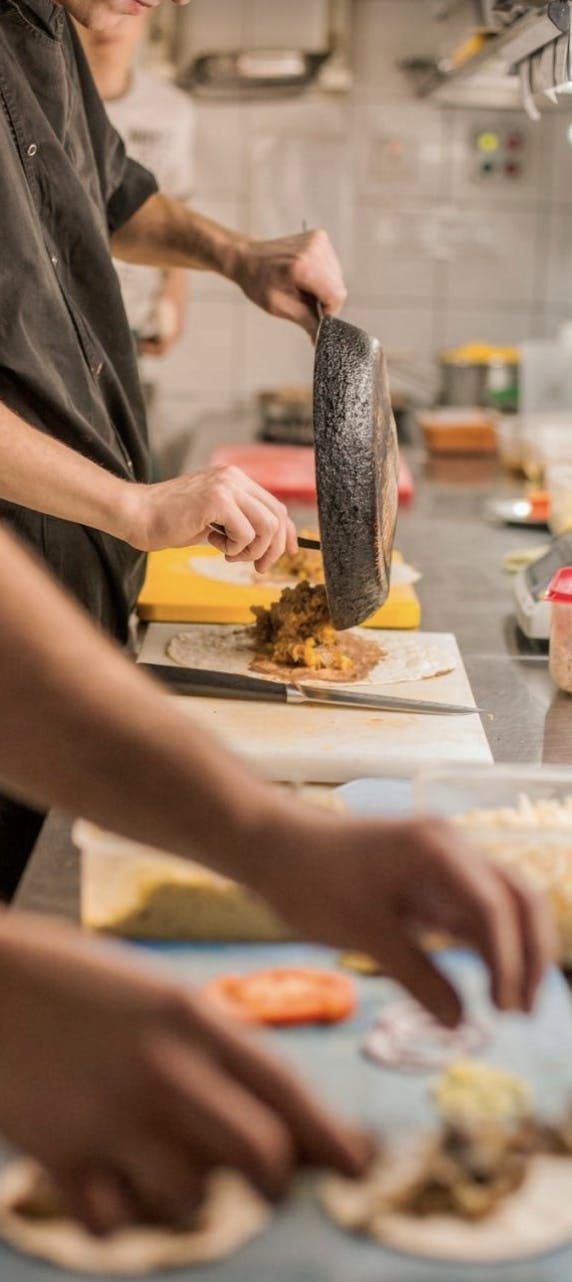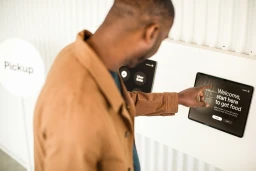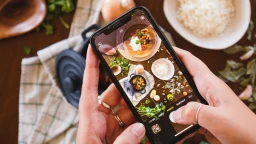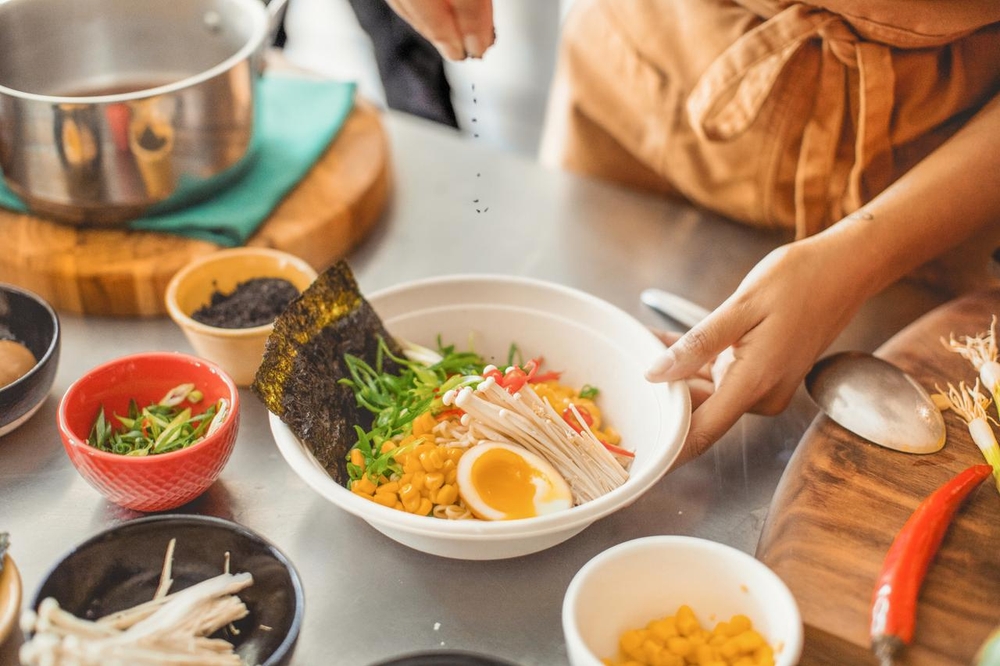Social Media Marketing Guide & Tips for Restaurants
Table of Contents
CloudKitchens
How many tacos can be delivered from a 1000sqft restaurant?
The same amount as a 200sqft ghost kitchen.
It’s unlikely to open any social media feed these days without being bombarded by photos of croquettes, cakes, and caviar. (And we’re not complaining.)
Diners love to share the visually stunning plates they’re about to dig into, and restaurants reap the rewards when they hit the share button on a social media platform. But is there more to social media restaurant marketing than serving up an alluring dish and raising a prayer to the Instagram gods?
In a word, yes. Social media marketing should be a top priority for your restaurant’s overall digital marketing strategy. Learning to finesse Facebook, game Twitter, and ignite Instagram can open new audiences to your culinary prowess. Dig in to discover how restaurant social media marketing can build and improve your brand awareness to more hungry customers.
Why is Social Media Important for Restaurants?
Social media was created to connect with friends. Nowadays, however, it’s a space for general information sharing and brand advertising.
Over 3 billion people have a social media account of one kind or another, with a high percentage of them in Western markets.
Perhaps only our need to eat permeates our lives as much as social media use (although we’re probably biased). Whatever your opinion on its prominence in our culture, savvy restaurateurs can use these two constants to their advantage.
Successful restaurants engage with their customers on each social media channel to foster relationships and develop communities around their brand with both new customers and existing customers. Food inventory management is the practice of sourcing, tracking, and expensing every ingredient that a restaurant business uses. Just like product inventory tracking in a retail or apparel store, food inventory must be overseen and measured in a restaurant.
Here are the key social media statistics for your review:
| Social Media | Active Users | Time spent | Gender mix | Age mix |
|---|---|---|---|---|
| 2.96 Billion | 33min/day | 56.6% male | 25-34 | |
| 2 Billion | 30min/day | 51.8% male | 18-34 | |
| 556 Million | 34.8min/day | 63% male | 18-44 | |
| TikTok | 113 Million | 23.5hr/mth | 46% male | 18-24 |
| YouTube | 30 Billion views | 19min/day | 53.95 male | 15-35 |
How Will an Engaged Fanbase Support Your Restaurant?
For existing customers, feeling like they’re on a first-name basis with their favorite eatery turns a diner into a devotee. They’ll spread the word about your delicious cuisine because they feel an emotional attachment to your restaurant business. And for that, they’ll tell your story and return for seconds—with a group of friends.
First, however, they need someone and somewhere to facilitate all of this sharing and connecting. Creating a social media profile for your restaurant on multiple platforms provides a space for your customers to be your invaluable brand advocates.
So how do you begin to tackle social media marketing for restaurant branding? By mastering the five social media channels where your customers are already hanging out:

1. This is No Meta-joke: Facebook is Seriously Important for Restaurants
Understanding the pivotal role of Facebook in the marketing landscape is crucial for restaurant operators. With a staggering 2.96 billion monthly active users as of Q4 2022, Facebook is not just a social media giant; it’s an invaluable tool for restaurant brands.
Considering the statistics that 90% of marketers globally prefer Facebook, and 70% of American adults are active on the platform, it becomes evident that Facebook is an essential ingredient in any restaurant’s social media strategy. An average American spends 33 minutes daily on Facebook, making it a prime channel to engage with potential customers.
By recognizing the significance of Facebook and implementing a comprehensive strategy, restaurant brands can effectively reach and engage with their audience, fostering a strong online presence.
Key Statistics:
- Scale & reach: Most-used social media platform by marketers worldwide (90%)
- Total active monthly users: 2.96 billion
- Avg time spent: 33 mins per day
- Gender mix: 56.6% male, 43.4% female
- Age group: 25-34
2. Guidelines for the ‘Gram
Instagram, boasting a whopping 2 billion monthly active users, is a powerhouse for restaurant operators looking to engage with a diverse and active audience.
Key statistics include U.S. adults spending an average of 30 minutes daily on the platform, with the highest usage among the 18 to 34 age group. Notably, 35% of consumers prefer content in the form of Stories, especially those with a mix of photos, videos, and text, as well as quizzes and polls.
Reels, a feature on Instagram, demonstrate the highest reach rate, standing at an impressive 14%, surpassing other media types. Moreover, a significant 90% of Instagram users follow a business, indicating a strong inclination to connect with brands on the platform.
By aligning with the preferences and behaviors of Instagram’s extensive user base, restaurant operators can effectively utilize the platform to enhance brand visibility and engage with a wide audience.
Key Statistics:
- Scale & reach: 2nd most-used social media platform by marketers worldwide (79%)
- Total active monthly users: 2 billion
- Avg time spent: 30 mins per day
- Gender mix: 51.8% male, 48.2% female
- Age group: 18-34
3. Tweeting (X) Success: Restaurant Marketing Strategies
Twitter marketing remains a valuable strategy for restaurant operators, despite some shifts in usage patterns. With approximately 556 million monthly active users worldwide, Twitter remains a significant platform for engaging a diverse audience. Notably, 53% of Twitter users rely on the platform for real-time news updates, making it a dynamic space to share restaurant announcements, promotions, and updates.
Although 71% of marketers plan to spend less time on Twitter in 2023, this could represent an opportunity for savvy restaurant operators. The average daily usage of 34.8 minutes indicates that users are spending meaningful time on the platform, offering a window for effective engagement.
Moreover, Twitter’s recent features, such as Twitter Spaces, suggest a potential resurgence in the platform’s popularity. These innovations provide unique opportunities for restaurants to connect with their audience in more interactive and immersive ways.
Demographically, Twitter’s user base is diverse, with 63% being men. The age distribution, with 38.5% between 25–34 years old, aligns well with the target demographic for many restaurants. Additionally, cross-platform usage with Instagram, LinkedIn, and Facebook offers integrated marketing possibilities.
While there have been shifts in sentiment and some metrics like cost per engagement increased, Twitter’s positive overall sentiment and high ad view time (26% higher than other leading platforms) indicate that it remains an influential space for brand visibility.
In conclusion, despite changing trends, Twitter offers a unique and dynamic space for restaurant operators to engage with their audience, share news, and build a brand presence
Key Statistics:
- Scale & reach: 71% to spend less on Twitter
- Total active monthly users: 556 mil
- Avg time spent: 34.8 mins per day
- Gender mix: 63% male, 37% female
- Age group: 18-44
4. Don’t Overlook TikTok: A Game-Changer for Restaurants
In the dynamic landscape of digital marketing, TikTok has swiftly evolved into an indispensable platform for brands. With over 1 billion active users worldwide and an average usage of 23.5 hours per month per user, TikTok stands out as the most frequently used app globally. Although its user base skews towards younger demographics, particularly with 38.9% aged 18-24, brands need to note that 54% of users are identified as female. The platform’s unique appeal lies in its emphasis on fun and entertaining content, with 78.9% of users seeking precisely that.
While younger consumers and smaller influencers currently dominate TikTok, brands should recognize this as an opportunity to connect with a growing audience. Notably, TikTok surpassed Instagram as the most downloaded app in Q1 2022, and its parent company, Bytedance, generated a staggering $821 million in consumer spending during the same period. Moreover, TikTok boasts the highest engagement rate among social media platforms, making it a powerful tool for brand interaction.
TikTok’s impact on purchasing decisions is significant, with 55% of users making a purchase after encountering a brand on the platform. Live shopping on TikTok is also gaining traction, with 50% of users making a purchase directly linked to watching a TikTok Live session.
Incorporating TikTok into a marketing strategy is crucial for brands aiming to stay relevant and engage with a broad audience. With its unprecedented growth and potential for brand visibility, TikTok is not just a passing trend but a transformative force in the social media landscape. For brands contemplating TikTok marketing, understanding these statistics is the first step toward leveraging the platform’s vast potential.
Key Statistics:
- Scale & reach: most downloaded app in 2022
- Total active monthly users: 113 mil
- Avg time spent: 23.5 hours per month
- Gender mix: 54% identify as women
- Age group: 18-44
5. Embrace YouTube Presence: Engage, Grow, Thrive
In an era dominated by digital content, the imperative for restaurant operators to establish a presence on YouTube is evident. As of January 2023, YouTube boasts a staggering 2.5 billion users worldwide, making it a colossal platform for brand exposure. While there has been a marginal decrease in active users, YouTube Shorts alone garners a phenomenal 30 billion daily views globally, attesting to the enduring popularity of the platform.
The demographic distribution on YouTube aligns strategically with the target audience for restaurants. With 77% of internet users between the ages of 15-35 on YouTube and significant representation across other age groups, it offers a diverse market for culinary content. The platform’s accessibility is paramount, with nearly 90% of visits originating from mobile devices, catering to the modern user’s preference for on-the-go content.
YouTube’s role in advertising cannot be overstated, generating a substantial $7.9 billion in ad revenue in Q4 2021. Furthermore, YouTube ads are perceived as more relevant than linear TV advertising, providing a targeted avenue for restaurant operators to reach potential customers. With over 1 billion hours of video content viewed daily, YouTube offers an engaged audience hungry for visually appealing culinary experiences.
In the expansive digital landscape, YouTube is not just a video-sharing platform; it is a cultural phenomenon and an unparalleled opportunity for restaurant operators to showcase their offerings, engage with a vast audience, and carve a niche in the competitive digital marketplace.
Key Statistics:
- Scale & reach: 2.5 billion users worldwide
- Total active monthly users: 30 billion views daily
- Avg time spent: 19 minutes per day
- Gender mix: 53.9% male, 46.1% female
- Age group: 15-35 are on YouTube, along with 73% of users aged 36-45, 70% of users aged 46-55 and 67% of users aged 56+
Pros & Cons of Social Media Marketing Channels
Social media marketing presents advantages and challenges. Facebook is widely used, but algorithm changes impact visibility. Instagram engages with ease, but follower growth requires financial investment. Twitter is a primary news source, but shifts in user behavior are uncertain. TikTok enhances visibility but struggles with creating lasting impressions. YouTube broadens its reach but demands significant time and cost for high-quality video production.
Choose the best social media channel/s that best fits your restaurant’s needs:
| Social Media | Pros | Cons |
|---|---|---|
| Facebook remains the primary social platform, widely used, including Facebook Messenger. | Facebook’s algorithm changes can limit organic reach, impacting restaurant operators’ visibility. | |
| Instagram Stories and Reel content are rather engaging yet easier to produce, especially Behind-the-scene (BTS) content. | Growing a follower base is challenging without financial investment. | |
| The Go-To News source for US readers | Given recent changes, it remains uncertain whether users will gradually transition to alternative platforms or not. | |
| TikTok | TikTok’s viral potential enhances restaurant visibility, reaching diverse audiences and boosting engagement. | YouTube broadens its reach, showcasing restaurant culture, dishes, and attracting diverse audiences effectively. |
| YouTube | YouTube broadens its reach, showcasing restaurant culture, and dishes, and attracting diverse audiences effectively. | High cost and time to produce good quality YouTube video |
12 Social Media Tips for Your Restaurant
1. Build Your Social Profile and Align The Brand Messages
The first step in restaurant social marketing involves setting up your profile (Instagram Example). Verify that your business bios or details are current and that your logo and brand colors are accurate. Ensure all profile links are functional, directing users to the right pages. Include essential information such as website links, contact details, menu links, operating hours, and address, and if possible, integrate a map for convenience.
2. Be Responsive And Manage Review and Rating
Engage with users on your community page actively, responding promptly and utilizing automated replies for basic queries during busy periods.
Effective online reputation management (ORM) for restaurants involves
- Assessing online presence
- Optimizing Google Business Profile (GBP) or Yelp
- Updating owned brand assets
- Responding to reviews promptly
- Maintaining review site listings, optimizing for mobile
- Considering professional ORM assistance when needed
A positive online reputation is essential for customer attraction, and the guide suggests proactive strategies for building and safeguarding a restaurant’s digital image.
3. Create Unique Content and Hashtags
Capture the true essence of your food moments with unique content. Enhance the ambiance through optimized lighting and showcase your restaurant creatively. Hashtags play a vital role in social media success. Originating as categorization tools, they increase discoverability and engagement.
4. Test Out Different Content Styles and Format
Facebook and Instagram are versatile platforms. Use them for reservations, showcasing your menu, and directing users to order online. Experiment with different features and formats such as videos, posts, reels, stories, and carousels, to understand what resonates with your audience. Here are the different sizes of Instagram content.
5. Quality matters
Quality is imperative for restaurant operators on platforms like Instagram and TikTok. High-quality content not only grabs attention with crisp visuals and clear audio but also enhances brand credibility, influencing trust and engagement.
Social media algorithms favor quality, improving visibility. User engagement, positive brand image, standing out in a competitive landscape, meeting platform expectations, and fostering shareability for organic growth are all benefits of prioritizing content quality.
Overall, it’s a strategic necessity, shaping perceptions and contributing to social media success.
6. Trendjacking Your Content
Discover trends through Google Trends, follow popular hashtags, and leverage BuzzSumo. Create content in sync with these trends to ride the wave, fostering virality. This strategic approach enhances engagement, elevating brand awareness for your restaurant on social media platforms.
7. Post Engaging Behind-The-Scenes (BTS) Content
Share updates on specials, stories, and events. Express your restaurant’s personality by posting not only about food but also about the people behind the scenes. Celebrate wins and showcase the staff to create a personal connection with your audience. Include employees in your content to convey authenticity and provide a fun glimpse into how the food is prepared and cooked.
8. Leverage On FREE User-Generated Content (UGC)
Leveraging User-Generated Content (UGC) offers businesses, like restaurants, numerous benefits—cost-effectiveness, authenticity, showcasing brand loyalty, and community building. The recommended steps for successful UGC campaigns:
- Emphasizing goal-setting
- Selecting suitable platforms
- Inspiring audience participation
- Showcasing UGC effectively
It highlights the importance of contributor engagement, integration into marketing campaigns, and metrics for measuring success, providing actionable insights for a powerful online presence and audience connection.
9. Run Effective Contest Periodically
A well-run contest not only boosts visibility and engagement, it helps to strengthen the positive brand image and also encourages customer loyalty. Executing effective social media contests for restaurant owners entails:
- Defining precise goals
- Choosing appropriate platforms
- Outlining contest rules
- Providing alluring prizes
- Promoting the contest adeptly
Quick tips: Ensuring clarity in rules and incorporating mechanics that encourage participants to tag or share, amplifying post reach and engagement.
10. Harness The Power Of Promotion & Discount
Harnessing discounts on social media provides restaurants with various advantages, such as heightened visibility, increased customer engagement and loyalty, the attraction of new patrons, gaining a competitive edge, showcasing new offerings, building community, and collecting valuable data for personalized marketing strategies.
Quick tips: To use this lever sparingly and do not engage in frequent promotions, as their attractiveness diminishes with overuse. Additionally, tying promotions and discounts with significant seasonal trends and holidays can enhance their impact.
11. Don’t Forget to Add CTA to Your Content
Including effective Call-to-Action (CTA) elements in social media content is crucial for restaurant operators to drive bottom-line sales. Specific CTAs like “Reserve/Book Now” “Find/Reserve Table,” “View/See Menu/Specials”, “Find Restaurant/Location”, or “Use the Promo Code Now” provide clear instructions to the audience, encouraging immediate action. This not only enhances customer engagement but also prompts conversions, turning online interactions into real-world transactions. Well-crafted CTAs create a sense of urgency and guide customers on the next steps, contributing to increased foot traffic, sales, and overall business success.
Quick tips: Create urgency and scarcity for restaurant promotions CTA by using terms like “TODAY” or “NOW.” This taps into psychological triggers, boosting conversions.
12. Amplify Brand Awareness With Social Influencers
Restaurant operators can amplify their brand through influencer collaborations. By prioritizing authenticity, building genuine relationships, and leveraging influencers’ engaged audiences, operators can enhance brand visibility. Leveraging different effective strategies, you can navigate this dynamic landscape to drive success for your restaurant brand. A list of food influencers that you can engage.
Cook Up Photogenic, Post-worthy Plates With CloudKitchens
You can’t post high-quality photos of your delectable food on a social network without cooking it first. And you can’t cook fantastic food without the proper space and equipment to get the job done.
That’s where CloudKitchens comes in.
Our ghost kitchen set-up has the tools you need to whip up delicious, photo-worthy dishes to help with your brand awareness. And what’s more, our home-baked fulfillment system helps you expand your operation to hungry customers in your area. Hello, new social media followers!
CloudKitchens provides spaces for you to break into the biz without laying down the costly capital. If you want to start a restaurant and are curious about building your brand without a brick-and-mortar space, consider learning more about ghost kitchen marketing.
When you’re ready to take the leap, contact us to schedule a tour of our kitchens and see why we’re changing the industry for restauranteurs everywhere. Now that’s social proof.
Explore ghost kitchen locations across the US:
- Ghost kitchens in San Francisco
- Ghost kitchens in LA
- Ghost kitchens in NYC
- Ghost Kitchens in Toronto
- Ghost Kitchens in Atlanta
- Ghost Kitchens in Dallas
- Ghost Kitchens in Chicago
- Ghost Kitchens in Denver
- Ghost Kitchens in Miami
| DISCLAIMER: This information is provided for general informational purposes only and the content does not constitute an endorsement. CloudKitchens does not warrant the accuracy or completeness of any information, text, images/graphics, links, or other content contained within the blog content. We recommend that you consult with financial, legal, and business professionals for advice specific to your situation. |
Sources:
National Library of Medicine. The Future of Social Media in Marketing. https://www.ncbi.nlm.nih.gov
National Library of Medicine. Role of Social Media Marketing Activities in Influencing Customer Intentions: A Perspective of a New Emerging Era. https://www.ncbi.nlm.nih.gov/
Harvard Journal of Law and Technology. Google and Search-engine Market Share. https://jolt.law.harvard.edu/
Tufts University. Social Media Overview. https://communications.tufts.edu/
National Library of Medicine. The Use of Facebook Advertising for Communicating Public Health Messages: A Campaign Against Drinking During Pregnancy in New Zealand. https://www.ncbi.nlm.nih.gov/
National Library of Medicine. Effect of Online Reviews and Crowd Cues on Restaurant Choice of Customer: Moderating Role of Gender and Perceived Crowding. https://www.ncbi.nlm.nih.gov/
University of Maine. Social Media Statistics Details. https://umaine.edu/
New York Film Academy. 5 Essential Tips for Great Food Photography. https://www.nyfa.edu/
GlobeNewsWire. Brand Rated: “Nine Out of Ten Customers Read Reviews Before Buying a Product” https://www.globenewswire.com/news-release/2022/01/13/2366090/0/en/Brand-Rated-Nine-out-of-ten-customers-read-reviews-before-buying-a-product.html
More insights & stories
There’s more where that came from.
Get in the know and check out our additional insights




